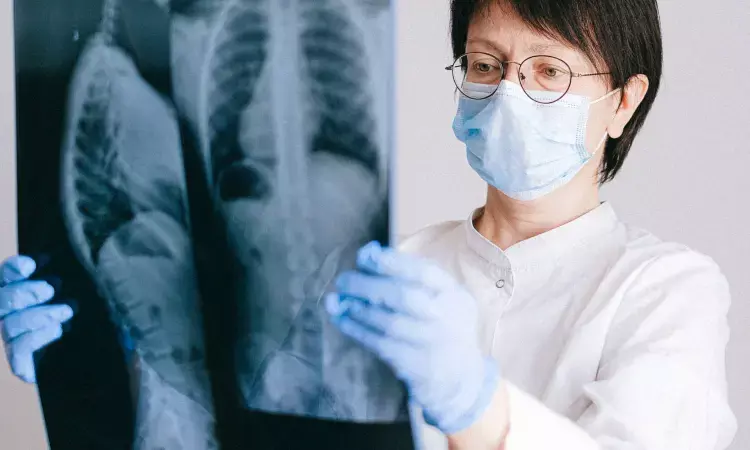- Home
- Medical news & Guidelines
- Anesthesiology
- Cardiology and CTVS
- Critical Care
- Dentistry
- Dermatology
- Diabetes and Endocrinology
- ENT
- Gastroenterology
- Medicine
- Nephrology
- Neurology
- Obstretics-Gynaecology
- Oncology
- Ophthalmology
- Orthopaedics
- Pediatrics-Neonatology
- Psychiatry
- Pulmonology
- Radiology
- Surgery
- Urology
- Laboratory Medicine
- Diet
- Nursing
- Paramedical
- Physiotherapy
- Health news
- Fact Check
- Bone Health Fact Check
- Brain Health Fact Check
- Cancer Related Fact Check
- Child Care Fact Check
- Dental and oral health fact check
- Diabetes and metabolic health fact check
- Diet and Nutrition Fact Check
- Eye and ENT Care Fact Check
- Fitness fact check
- Gut health fact check
- Heart health fact check
- Kidney health fact check
- Medical education fact check
- Men's health fact check
- Respiratory fact check
- Skin and hair care fact check
- Vaccine and Immunization fact check
- Women's health fact check
- AYUSH
- State News
- Andaman and Nicobar Islands
- Andhra Pradesh
- Arunachal Pradesh
- Assam
- Bihar
- Chandigarh
- Chattisgarh
- Dadra and Nagar Haveli
- Daman and Diu
- Delhi
- Goa
- Gujarat
- Haryana
- Himachal Pradesh
- Jammu & Kashmir
- Jharkhand
- Karnataka
- Kerala
- Ladakh
- Lakshadweep
- Madhya Pradesh
- Maharashtra
- Manipur
- Meghalaya
- Mizoram
- Nagaland
- Odisha
- Puducherry
- Punjab
- Rajasthan
- Sikkim
- Tamil Nadu
- Telangana
- Tripura
- Uttar Pradesh
- Uttrakhand
- West Bengal
- Medical Education
- Industry
Individualized Stereotactic ablative radiotherapy may help minimize dosage in lung tumor: JAMA

Individualized Stereotactic ablative radiotherapy (iSABR) used for managing lung tumours allows minimization of treatment dose and tied to excellent local control, according to an Original Investigation published on September 14, 2023, in JAMA Oncology.
This study, “Individualized Stereotactic Ablative Radiotherapy for Lung TumorsThe iSABR Phase 2 Nonrandomized Controlled Trial”, is led by lead author Dr Michael F. Gensheimer, MD and co-author Harriet Gee, MD, PhD and colleagues.
SABR is used for the management of lung tumors. However, it has toxic effects and can cause life-threatening damage to central structures. Based on insights from retrospective data, researchers say that small tumors up to 10 cm3 in volume are well controlled with a biologically effective dose of less than 100 Gy.
Is there an association between individualizing dose and fractionation of SABR by tumor size, location, histological characteristics and local control in lung tumor management?
This was studied in the present nonrandomized controlled trial in which participants were enrolled from November 15, 2011, to December 5, 2018, at academic medical centres in the US and Japan.
The study had three groups based on cancer type.
Group 1: Initial non–small cell lung cancer (NSCLC) diagnosis with an American Joint Committee on Cancer 7th edition T1-3N0M0 tumor.
Group 2: T1-3N0M0 new primary NSCLC with a history of prior NSCLC or multiple NSCLCs
Group 3: Lung metastases
Up to 4 tumors were treated with once-daily SABR. The dose ranged from 25 Gy in 1 fraction for peripheral tumors with a volume of 0 to 10 cm3 to 60 Gy in 8 fractions for central tumors with a volume greater than 30 cm3.
The primary outcome was Per-group Freedom from local recurrence at one year, with censoring at the time of distant recurrence, death, or loss to follow-up.
The key findings of the study are:
- The study had 217 unique patients with a median age of 72 years, including 59 % male. These were followed up for 33 months.
- 69 % were current or former smokers.
- The treatment courses in groups 1, 2 and 3 were 79, 82 and 79, respectively.[total 240]
- Two hundred-eleven peripheral tumors and 74 central tumors, constituting 74 % each, were treated with 285 tumors.
- 25 Gy in 1 fraction was the most common dose.
- The median overall survival was 59 months.
- Freedom from local recurrence at one year for groups 1, 2 and 3 was 97%, 94%, and 96%, respectively.
- In the three groups, Freedom from local recurrence at five years was in the range of 83% to 93%.
- 5 % of patients presented with grade 3 to 5 toxic effects. This proportion was low.
- A single patient had a grade 5 toxic effect.
An individualized dosing regimen, including doses lower than those routinely administered, presents with excellent tumor control.
Based on the results from this study, iSABR allows the minimization of treatment doses for managing lung tumors and has excellent local control.
For further investigations and future trials, consideration should be given to individualized dosing.
Further reading:
Gensheimer MF, Gee H, Shirato H, et al. Individualized Stereotactic Ablative Radiotherapy for Lung Tumors: The iSABR Phase 2 Nonrandomized Controlled Trial. JAMA Oncol. Published online September 14, 2023. doi:10.1001/jamaoncol.2023.3495
BDS, MDS in Periodontics and Implantology
Dr. Aditi Yadav is a BDS, MDS in Periodontics and Implantology. She has a clinical experience of 5 years as a laser dental surgeon. She also has a Diploma in clinical research and pharmacovigilance and is a Certified data scientist. She is currently working as a content developer in e-health services. Dr. Yadav has a keen interest in Medical Journalism and is actively involved in Medical Research writing.
Dr Kamal Kant Kohli-MBBS, DTCD- a chest specialist with more than 30 years of practice and a flair for writing clinical articles, Dr Kamal Kant Kohli joined Medical Dialogues as a Chief Editor of Medical News. Besides writing articles, as an editor, he proofreads and verifies all the medical content published on Medical Dialogues including those coming from journals, studies,medical conferences,guidelines etc. Email: drkohli@medicaldialogues.in. Contact no. 011-43720751


